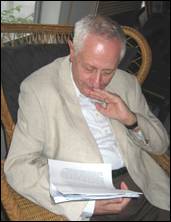Marcel Kornitzer
Year: November 10th, 2003
Location: Florida
Interviewed by: Blackburn, Henry
Abstract
Marcel Kornitzer pioneered CVD epidemiology in Belgium and the Continent, and we speak here of the innovation of his chief, Jean Lequime, getting him involved first with travels to Italy and England, and in the Belgian Bankers Study. He describes his epiphany at the 1970 Blessington 10-day CVD Epidemiology Seminar, when Geoffrey Rose invited him to join the WHO multifactor trial in industry.
He ranges over his long collaboration with Guy DeBacker and their exploration of causes for the north-south, Flemish-Walloon differences in CVD rates, establishing diet and serum cholesterol differences as well as the socioeconomic and cultural differences.
Kornitzer and collaborators were early in trials and observational studies, in ecologic studies, in psycho-social risk factors, in arm-ankle pulse differences, and in the demonstration of the greater predictive role of physical fitness over activity questionnaires.
He remains active in writing long term follow up in these populations, from his retirement in Israel and participates in our history enterprise with fact and anecdote. (Henry Blackburn)
Quotes
Role of Lequime
I suspect that he [Prof. subject Lequime] joined or didn’t join too late for Seven Countries, and so he called me in ’64 and said: ‘I would like to have somebody who would be interested in epidemiology and I would like to start something here in my department in cardiovascular epidemiology.; He didn’t speak about prevention at that point. He said, “I’ll give you two days. Go to the library and look up the Framingham Study.”
As I wrote to you earlier, I was sure that must be a guy named Framingham.
Psychosocial pioneering
But WHO started, based on cultural differences, what they called the Rotterdam-Kaunas Study. It was a study of incidence rates, which were higher in Kaunas and Ed Appels was working with them and he tried to find there if Type A was a predictor. It was not, in that study. But my crew then… started to learn pragmatically how to use the Balther (word) Scale. We used the Balther Scale, the Jenkins, and the Roseman-Friedman typing… and we had mixed results… in the control group, which was only 900 people… Type A came out as an independent risk factor besides cholesterol, blood pressure and smoking. And I made then some reviews and the reviews were very mixed. In Europe there was much less predictive power than you had early in the United States. So I became really more engaged… and focused on psycho-social factors and these things.
On French-Flemish diet-cholesterol differences
So that at the same place you have richer people, which were the French, and poorer people, which were all the Flemish people. But the poorest of the poor were the coal miners of the Campagne and for Joseph Joossens the idea behind this was that the cultural difference was due to social differences, to being rich or poor, whether to move to margarine or not. The whole of cooking was then done with this poor fat, which is margarine in the north. Not for everybody, of course, but for a majority. And the whole cooking in the south was still with butter. And I remember when I went to visit Wallonia after the war when I was grown up and you passed a restaurant you had to see it because on the outside it was written, “Cuisine au Beurre.” And cuisine au beurre means high quality. And this comes from France and so whatever is not cuisine au beurre cannot be quality.
In WWII, I can tell you that a lot of Belgians couldn’t afford butter. My mother wanted, at least, to have butter for her son, that’s for her son, me. So she went to the farmers and she had to give something like a diamond ring or something like this. During the war that would amount to for a kilo of butter something like 10,000 Belgian francs, which is $300 for one kilo of butter… So I can imagine if you see this cultural idea of people, if I buy margarine they see that I am a poor guy. And margarine is bad because you only eat it when you are poor or when there’s a war. So it’s bad. So this makes the whole cultural background… it’s better to say socio-cultural, between north and south and this is fascinating because now in the north Flanders is the richest part and Wallonia is the poorest part, reversed. Things change, you know.
On sociocultural differences in Belgium
And I would say I think there are more than nutritional differences and if you say it is a cultural difference, then it’s going beyond nutrition and you could have other things – eating patterns – and it could be other things…On job stress we had a lot of psycho-social factors that we measured, not only job status. And this is a paper only looking at south and north differences in factories, in males and in females, in all the psycho-social factors, and we adjusted for levels of education and age. And we found that the score for depression is higher in the south. We found the score of job stress, characteristic job stress is higher, and the prevalence of strain is higher in the south… at least five different factors were worse in the south than in the north.
Physical Fitness versus Physical Activity
There was a guy called Sabalski [working with us] who made his thesis on physical activity and physical fitness and he published then the paper where physical fitness was an individual predictor and not physical activity. And it was quoted in this famous book from the CDC. [Ours was] one of the two studies looking at the same time at physical fitness and physical activity… and it’s quoted.
Full Transcript Access
Full transcripts of interviews may be made available to those engaged with original materials for scholarly studies by contacting us.
